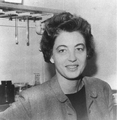Template:Selected anniversaries/August 20: Difference between revisions
No edit summary |
No edit summary |
||
| (2 intermediate revisions by the same user not shown) | |||
| Line 61: | Line 61: | ||
||1923, the first American-built rigid dirigible was launched in Lakehurst, N.J, later christened the U.S.S. Shenandoah (“daughter of the stars”). It was the first of the Zeppelin type (ZR-1) to use helium gas, of which a supply was was available in the U.S. It was tested in flight the following month, on 3 Sep 1923, and christened 10 Oct 1923. Covered with an aluminum-painted fabric, it was 680 feet long, weighed 36 tons, could bear 55 tons, and carry enough fuel to cruise 5,000 miles at an average speed of 65 mph. It was commanded by Commander Zachery Lansdowne (1888-1925), an early Navy aviator, who died with 14 members of the crew when the airship was struck and destroyed in a violent thunderstorm on 3 Sep 1925 over Caldwell, Ohio, though 29 of the crew survived. | ||1923, the first American-built rigid dirigible was launched in Lakehurst, N.J, later christened the U.S.S. Shenandoah (“daughter of the stars”). It was the first of the Zeppelin type (ZR-1) to use helium gas, of which a supply was was available in the U.S. It was tested in flight the following month, on 3 Sep 1923, and christened 10 Oct 1923. Covered with an aluminum-painted fabric, it was 680 feet long, weighed 36 tons, could bear 55 tons, and carry enough fuel to cruise 5,000 miles at an average speed of 65 mph. It was commanded by Commander Zachery Lansdowne (1888-1925), an early Navy aviator, who died with 14 members of the crew when the airship was struck and destroyed in a violent thunderstorm on 3 Sep 1925 over Caldwell, Ohio, though 29 of the crew survived. | ||
||1930: Herbert Hall Turner dies ... astronomer and seismologist. Pic search. | ||1930: Herbert Hall Turner dies ... astronomer and seismologist. Pic search. | ||
| Line 80: | Line 78: | ||
File:Percy Williams Bridgman.jpg|link=Percy Williams Bridgman (nonfiction)|1961: Physicist and academic [[Percy Williams Bridgman (nonfiction)|Percy Williams Bridgman]] dies. He won the 1946 Nobel Prize in Physics for his work on the physics of high pressures. | File:Percy Williams Bridgman.jpg|link=Percy Williams Bridgman (nonfiction)|1961: Physicist and academic [[Percy Williams Bridgman (nonfiction)|Percy Williams Bridgman]] dies. He won the 1946 Nobel Prize in Physics for his work on the physics of high pressures. | ||
File:Alice Beta.jpg|link=Alice Beta|1962: Mathematician and crime-fighter [[Alice Beta]] publishes new class of | File:Alice Beta.jpg|link=Alice Beta|1962: Mathematician and crime-fighter [[Alice Beta]] publishes new class of Gnomon algorithm functions which detect and prevent crimes against mathematical constants. | ||
||1962: The NS Savannah, the world's first nuclear-powered civilian ship, embarks on its maiden voyage. | ||1962: The NS Savannah, the world's first nuclear-powered civilian ship, embarks on its maiden voyage. | ||
| Line 101: | Line 99: | ||
||2006: Mathematician Bill Parry dies. Parry contributed to dynamical systems, and, in particular, ergodic theory, and made significant contributions to these fields. He is considered to have been at the forefront of the introduction of ergodic theory to the United Kingdom. He played a founding role in the study of subshifts of finite type, and his work on nilflows was highly regarded. Pic. | ||2006: Mathematician Bill Parry dies. Parry contributed to dynamical systems, and, in particular, ergodic theory, and made significant contributions to these fields. He is considered to have been at the forefront of the introduction of ergodic theory to the United Kingdom. He played a founding role in the study of subshifts of finite type, and his work on nilflows was highly regarded. Pic. | ||
File:Elizabeth Dexter Hay.png|link=Betty Hay (nonfiction)|2007: Cell and developmental biologist [[Betty Hay (nonfiction)|Elizabeth Dexter “Betty” Hay]] dies. Hay conducted pioneering research in limb regeneration, the role of the extracellular matrix (ECM) in cell differentiation, and epithelial-mesenchymal transitions (EMT). | |||
||2008: Sergey Mergelyan dies ... mathematician who made major contributions to Approximation Theory. Pic. | ||2008: Sergey Mergelyan dies ... mathematician who made major contributions to Approximation Theory. Pic. | ||
</gallery> | </gallery> | ||
Latest revision as of 04:43, 11 March 2022
1672: Mathematician and politician Johan de Witt dies in a riot. The rioters will partially eat his body.
1797: Physicist and priest Francesco Zantedeschi born. Zantedeschi will be among the first to recognize the marked absorption by the atmosphere of red, yellow, and green light. He will also think that he detected, in 1838, a magnetic action on steel needles by ultraviolet light, anticipating later discoveries connecting light and magnetism.
1864: The Kinmon incident: a rebellion against the Tokugawa shogunate breaks out near the Imperial Palace in Kyoto. The rebels will seek to restore the Imperial household to its position of political supremacy.
1911: The first cable message sent around the world from the U.S. by commercial telegraph was transmitted from New York City. It read “This message sent around the world,” left the New York Times building at 7:00 pm and was received at 7:16 pm after travelling nearly 29,000 miles through 16 relays via the Azores, Gibraltar, India, Phillipines, Midway, Guam, Hawaii and San Francisco.
1912: Thomas Edison receives U.S. patent No. 1036470 for a “Phonographic Apparatus,” and No. 1036471 for a “Storage Battery.”
1942: The first visible quantity of a plutonium compound, plutonium(IV) iodate, is isolated by nuclear chemists Burris Cunningham and Louis Werner.
1961: Physicist and academic Percy Williams Bridgman dies. He won the 1946 Nobel Prize in Physics for his work on the physics of high pressures.
1962: Mathematician and crime-fighter Alice Beta publishes new class of Gnomon algorithm functions which detect and prevent crimes against mathematical constants.
2007: Cell and developmental biologist Elizabeth Dexter “Betty” Hay dies. Hay conducted pioneering research in limb regeneration, the role of the extracellular matrix (ECM) in cell differentiation, and epithelial-mesenchymal transitions (EMT).








